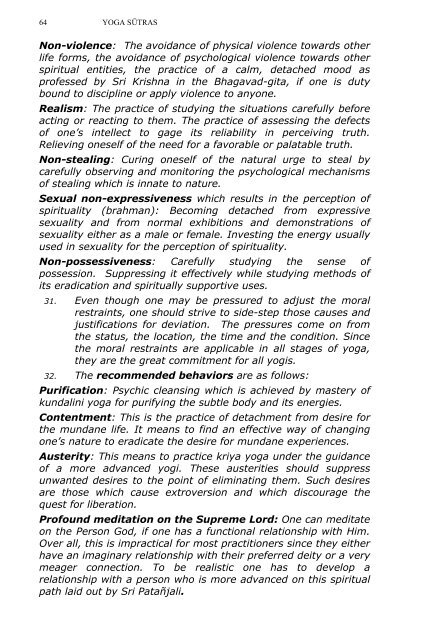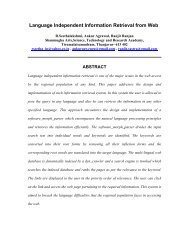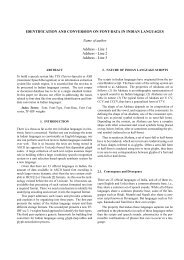You also want an ePaper? Increase the reach of your titles
YUMPU automatically turns print PDFs into web optimized ePapers that Google loves.
64 YOGA SŪTRAS<br />
Non-violence: The avoidance of physical violence towards other<br />
life forms, the avoidance of psychological violence towards other<br />
spiritual entities, the practice of a calm, detached mood as<br />
professed by Sri Krishna in the Bhagavad-gita, if one is duty<br />
bound to discipline or apply violence to anyone.<br />
Realism: The practice of studying the situations carefully before<br />
acting or reacting to them. The practice of assessing the defects<br />
of one’s intellect to gage its reliability in perceiving truth.<br />
Relieving oneself of the need for a favorable or palatable truth.<br />
Non-stealing: Curing oneself of the natural urge to steal by<br />
carefully observing and monitoring the psychological mechanisms<br />
of stealing which is innate to nature.<br />
Sexual non-expressiveness which results in the perception of<br />
spirituality (brahman): Becoming detached from expressive<br />
sexuality and from normal exhibitions and demonstrations of<br />
sexuality either as a male or female. Investing the energy usually<br />
used in sexuality for the perception of spirituality.<br />
Non-possessiveness: Carefully studying the sense of<br />
possession. Suppressing it effectively while studying methods of<br />
its eradication and spiritually supportive uses.<br />
31. Even though one may be pressured to adjust the moral<br />
restraints, one should strive to side-step those causes and<br />
justifications for deviation. The pressures come on from<br />
the status, the location, the time and the condition. Since<br />
the moral restraints are applicable in all stages of yoga,<br />
they are the great commitment for all yogis.<br />
32. The recommended behaviors are as follows:<br />
Purification: Psychic cleansing which is achieved by mastery of<br />
kundalini yoga for purifying the subtle body and its energies.<br />
Contentment: This is the practice of detachment from desire for<br />
the mundane life. It means to find an effective way of changing<br />
one’s nature to eradicate the desire for mundane experiences.<br />
Austerity: This means to practice kriya yoga under the guidance<br />
of a more advanced yogi. These austerities should suppress<br />
unwanted desires to the point of eliminating them. Such desires<br />
are those which cause extroversion and which discourage the<br />
quest for liberation.<br />
Profound meditation on the Supreme Lord: One can meditate<br />
on the Person God, if one has a functional relationship with Him.<br />
Over all, this is impractical for most practitioners since they either<br />
have an imaginary relationship with their preferred deity or a very<br />
meager connection. To be realistic one has to develop a<br />
relationship with a person who is more advanced on this spiritual<br />
path laid out by Sri Patañjali.










